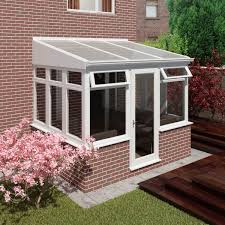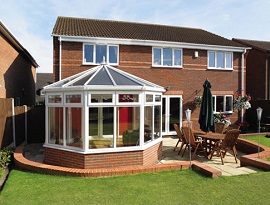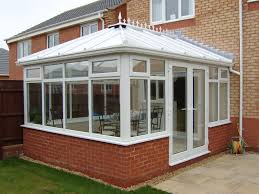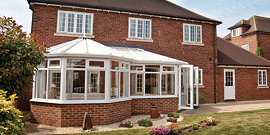Conservatory
Contents |
[edit] Introduction
A conservatory is a structure typically attached to a building such as a house consisting of low level brick walls with framed glazing above. In the UK, a space is considered to be a conservatory if it has glazing for at least 50% of its side wall area and at least 75% of its roof.
Traditionally, European cities built conservatories in the 19th century for horticultural purposes and for entertaining, although as far back as the 16th century wealthy landowners had built similar structures to cultivate citrus fruits. With the onset of the Second World War, there was a halt in the construction of conservatories in Britain, and they were only revived again in the 1970s. Today, conservatories are a popular way of maximizing the size of existing properties as the cost of moving to a new property has increased.
[edit] Types of conservatory
[edit] Lean-to
This type of conservatory gets its name from the fact that it appears to lean against the house. Lean-to conservatories are typically a simple rectangular or square shape with a gently sloping roof that is generally lower than other conservatory types. They can be particularly suitable for houses with limited garden space and bungalows.
It is usual for a lean-to to have dwarf walls, typically around 60 cm high, with glazing on all three sides as well as a glazed roof. A more affordable alternative is to use raised uPVC panels at the foot of the conservatory and polycarbonate for the roof. This is the most straight-forward and cheapest option for a conservatory.
[edit] Victorian
This is a period-design conservatory that is characterised by its rounded bay front and apex roof with a ridge along the top. The bay front can have a number of different facets – 3, 5 or 7 – depending upon preference. It is common for a Victorian conservatory to consist of a dwarf wall upon which the frames for the glazing sit. However, it is possible for floor-to-ceiling glazing to be used instead.
This is generally a more expensive option due to its slightly larger footprint as a result of the faceted front.
[edit] Edwardian
This is similar to a Victorian style but instead of the faceted front, it has a square, or rectangular shape and a pitched roof. The roof can take one of two common forms, either a gable end design where the end wall is flat, or a double-hipped design in which each side is a sloping roof including the end that slopes into the house.
[edit] P-shaped
A P-shaped conservatory is so called because one end is smaller than the other, with the larger end given a rounded effect with facets. This can often combine features of both Victorian and Edwardian designs, with the main advantage being that it offers more space which can, if required, be separated for different uses.
[edit] Planning permission
Generally, a conservatory is considered a permitted development which means that planning permission may not be needed. However, there are several conditions and limits:
- A conservatory cannot be built forward of the principal or side elevation or where it would be fronting a highway.
- A side conservatory cannot have a greater width than half the width of the original house (the house as it was first built or as it stood on 1 July 1948).
- Side and rear conservatories must be single-storey with a maximum height of 4 m.
- A single-storey rear conservatory must not extend beyond the rear wall of the original house by more than 3 m (if an attached house), or 4 m (if detached).
- Side and rear conservatories must have a maximum eaves height of 3 m if it is within 2 m of a boundary.
- The maximum eaves height should be no higher than the eaves of the existing house.
[edit] Building regulations
While building regulations generally tend to apply for house extensions, and any new structural opening between the existing house and the conservatory, the conservatory itself is often deemed to be exempt. This is provided that they are:
- Built at ground level.
- Have a floor area of less than 30 sq. m.
- Are separated from the house by walls, doors or windows.
- Are fitted with an independent heating system.
- Are fitted with glazing and electrical installations that comply with the applicable building regulations.
Generally, conservatories should not be placed where ladder access to windows intended for escape or rescue may be obstructed.
Conservatories can be poor at retaining heat. This can be mitigated by the use of energy-rated glazing and an external (insulated) door to separate the conservatory from the rest of the house.
Where it is intended to integrate the space into the rest of the building it may be necessary for it to be better insulated, with less glazing.
[edit] Scottish Building Standards
The Scottish Building Standards, Part I. Technical Handbook – Domestic, Appendix A Defined Terms, defines a conservatory as:
'...a building attached to a dwelling with a door and any other building elements dividing it thermally from that dwelling and having translucent glazing (including frames) forming not less than either:
- 75% of its roof area and 50% of its external wall area or
- 95% of its roof area and 35% of its external wall area.'
[edit] Related articles on Designing Buildings Wiki
- Building an extension.
- Dwarf wall.
- How to build a garage.
- How to build a porch.
- How to lay bricks.
- Licence to alter.
- Listed buildings.
- Mud room.
- Party Wall Act.
- Planning permission.
- Widow's walk.
[edit] External references
- Planning Portal – Conservatories
- House extension – Conservatory types
Featured articles and news
Government consultations for the summer of 2025
A year of Labour, past and present consultations on the environment, the built environment, training and tax.
CMA competitiveness probe of major housing developers
100 million affordable housing contributions committed with further consultation published.
Homes England supports Greencore Homes
42 new build affordable sustainable homes in Oxfordshire.
Zero carbon social housing: unlocking brownfield potential
Seven ZEDpod strategies for brownfield housing success.
CIOB report; a blueprint for SDGs and the built environment
Pairing the Sustainable Development Goals with projects.
Types, tests, standards and fires relating to external cladding
Brief descriptions with an extensive list of fires for review.
Latest Build UK Building Safety Regime explainer published
Key elements in one short, now updated document.
UKGBC launch the UK Climate Resilience Roadmap
First guidance of its kind on direct climate impacts for the built environment and how it can adapt.
CLC Health, Safety and Wellbeing Strategy 2025
Launched by the Minister for Industry to look at fatalities on site, improving mental health and other issues.
One of the most impressive Victorian architects. Book review.
Common Assessment Standard now with building safety
New CAS update now includes mandatory building safety questions.
RTPI leader to become new CIOB Chief Executive Officer
Dr Victoria Hills MRTPI, FICE to take over after Caroline Gumble’s departure.
Social and affordable housing, a long term plan for delivery
The “Delivering a Decade of Renewal for Social and Affordable Housing” strategy sets out future path.
A change to adoptive architecture
Effects of global weather warming on architectural detailing, material choice and human interaction.
The proposed publicly owned and backed subsidiary of Homes England, to facilitate new homes.
How big is the problem and what can we do to mitigate the effects?
Overheating guidance and tools for building designers
A number of cool guides to help with the heat.
The UK's Modern Industrial Strategy: A 10 year plan
Previous consultation criticism, current key elements and general support with some persisting reservations.
Building Safety Regulator reforms
New roles, new staff and a new fast track service pave the way for a single construction regulator.





























Comments
Great article!! Very useful resource for home improvement and conservatories. Well explained the types of conservatories. The p-shaped conservatory is best among them because it provides more space and can be separated if require more space.